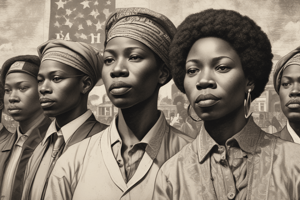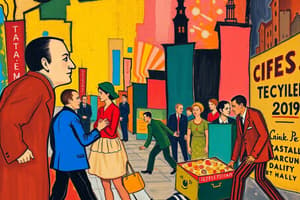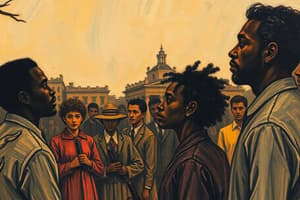Podcast
Questions and Answers
How many people attended the cinema in the 1920s?
How many people attended the cinema in the 1920s?
95 million people a week in 1929.
What was Clara Bow known for?
What was Clara Bow known for?
- Leading political protests
- Known as the 'It' girl (correct)
- Being a famous singer
- Writing novels
What was the first talkie film? When was it released?
What was the first talkie film? When was it released?
The Jazz Singer, released in October 1927.
What was the Hays Code?
What was the Hays Code?
Which sports became popular during the 1920s?
Which sports became popular during the 1920s?
What style of music became popular during the 1920s? Why?
What style of music became popular during the 1920s? Why?
What was the irony surrounding the Cotton Club?
What was the irony surrounding the Cotton Club?
Examples of dance crazes in the 1920s include?
Examples of dance crazes in the 1920s include?
What evidence is there of the popularity of radio?
What evidence is there of the popularity of radio?
What was a flapper?
What was a flapper?
What happened to fashion at the time?
What happened to fashion at the time?
Were most women flappers?
Were most women flappers?
What evidence is there that women made progress in the 1920s?
What evidence is there that women made progress in the 1920s?
What evidence is there that life didn't change for women in the 1920s?
What evidence is there that life didn't change for women in the 1920s?
When did women win the right to vote? What was the name of the law?
When did women win the right to vote? What was the name of the law?
What happened to divorce rates during this period?
What happened to divorce rates during this period?
What evidence is there that women did or did not have better employment opportunities in the 1920s?
What evidence is there that women did or did not have better employment opportunities in the 1920s?
Why did many Americans want to limit immigration in the 1920s?
Why did many Americans want to limit immigration in the 1920s?
What was the Red Scare?
What was the Red Scare?
How was immigration limited in the 1920s?
How was immigration limited in the 1920s?
Who were the two most famous victims of the Red Scare?
Who were the two most famous victims of the Red Scare?
What was the Sacco and Vanzetti case?
What was the Sacco and Vanzetti case?
Why were Sacco and Vanzetti executed?
Why were Sacco and Vanzetti executed?
Why did some people believe Sacco and Vanzetti were innocent?
Why did some people believe Sacco and Vanzetti were innocent?
What were the Jim Crow Laws?
What were the Jim Crow Laws?
What evidence is there of the popularity of the Ku Klux Klan in the 1920s?
What evidence is there of the popularity of the Ku Klux Klan in the 1920s?
Why did so many Americans join the KKK in the 1920s?
Why did so many Americans join the KKK in the 1920s?
How many lynchings took place each year?
How many lynchings took place each year?
What other problems did black Americans face during this decade?
What other problems did black Americans face during this decade?
Why had KKK membership declined by 1929?
Why had KKK membership declined by 1929?
When was prohibition introduced? What was the law called?
When was prohibition introduced? What was the law called?
Why was prohibition introduced?
Why was prohibition introduced?
How did most people ignore prohibition laws?
How did most people ignore prohibition laws?
What was moonshine and where was it made?
What was moonshine and where was it made?
Why was prohibition difficult to enforce?
Why was prohibition difficult to enforce?
How much smuggling went on at this time?
How much smuggling went on at this time?
How did the influence of gangsters grow?
How did the influence of gangsters grow?
Name a famous massacre during the prohibition era.
Name a famous massacre during the prohibition era.
Why did prohibition fail?
Why did prohibition fail?
Who repealed prohibition and why?
Who repealed prohibition and why?
Flashcards are hidden until you start studying
Study Notes
Attendance at the Cinema
- In 1929, weekly cinema attendance reached 95 million people.
Clara Bow
- Clara Bow became famous as the 'it' girl, embodying sex appeal.
- Her reputation for wild parties and love affairs raised concerns among conservative Americans regarding pre-marital sexual relationships.
The First Talkie Film
- "The Jazz Singer," the first talkie film, was released in October 1927.
Hays Code
- The Hays Code was enacted in 1930 due to concerns over film morality.
- Prohibited key elements like nudity, sexual dance sequences, and portrayed adultery negatively.
Popular Sports
- Golf gained fame through Bob Jones.
- Boxing became prominent with Jack Dempsey.
- Baseball star 'Babe' Ruth became an iconic figure of the sport.
Rise of Jazz and Blues
- Migration of African Americans from rural areas to cities popularized jazz and blues music.
Irony of the Cotton Club
- The Cotton Club, a prominent New York nightclub, was strictly whites-only despite featuring black performers.
Dance Crazes
- The Charleston and Black Bottom dances epitomized sexual suggestiveness, shocking the older generation.
Popularity of Radio
- Growth from one radio station in 1921 to 508 by 1922.
- Radio sales skyrocketed from $2 in 1920 to $600 million by 1929, with NBC earning $150 million annually.
Definition of a Flapper
- Flappers were women known for their short dresses, smoking, drinking, sports participation, and social independence.
Fashion Trends
- Fashion became more extravagant, with shorter and more vibrant dresses marking a liberal shift.
Presence of Flappers
- Many women were not flappers; rural women often lacked the means and opportunity to embrace the flapper lifestyle.
Progress for Women
- Urban women saw job opportunities rise by 24%, with 10 million employed by 1929; suffrage was granted with the 19th Amendment.
Continuing Challenges for Women
- Most women remained in low-paying jobs, faced gender discrimination, and flapper culture primarily represented urban upper-class women.
Women's Suffrage
- The 19th Amendment, passed in 1920, granted women the right to vote.
Divorce Rates
- By 1928, divorce rates rose to 166 per 1000 marriages, compared to 81 per 1000 in 1900.
Employment Opportunities for Women
- While female clerical positions grew, men still dominated managerial roles and well-paid jobs.
Concerns about Immigration
- Fears arose regarding Eastern European immigrants potentially bringing communist ideologies and the economic impacts post-WW1, leading to a rise in socialist strikes.
The Red Scare
- Heightened racism and fear of communism defined the era, following Russia's shift to communism.
Immigration Restrictions
- The Palmer Raids targeted suspected radicals, leading to the deportation of 10,000 immigrants.
- The Johnson-Reed Act of 1924 established a limit of 150,000 immigrants annually.
Famous Victims of the Red Scare
- Sacco and Vanzetti, Italian anarchists wrongfully executed for robbery and murder, became symbols of injustice.
Sacco and Vanzetti Case
- Arrested in 1920, they were found guilty mainly due to prejudicial views held by Judge Webster Thayer.
Racial Segregation
- Jim Crow Laws enforced racial segregation, denying black people access to public facilities and voting rights.
Ku Klux Klan Popularity
- The Klan's revival in 1915 peaked at 5 million members by 1925, promoted by favorable depictions in cultural media.
Lynching Statistics
- Approximately 50 lynchings per year occurred in the South during the early 1920s.
Challenges Faced by Black Americans
- Northern black Americans struggled against systemic racism, facing poor housing, limited job opportunities, and low wages.
Decline of KKK Membership
- A violent reputation and scandal, such as the Grand Wizard's conviction for murder, led to decreased membership by 1929.
Prohibition Introduction
- Prohibition began in January 1920 with the Volstead Act, aimed at reducing alcohol consumption.
Justifications for Prohibition
- Concerns over moral decline, public campaigns against alcohol, and a patriotic push during WW1 contributed to Prohibition's inception.
Evasion of Prohibition
- Many Americans circumvented prohibition through the creation of speakeasies and illegal stills.
Moonshine Production
- Homemade alcohol known as moonshine was widely produced in illicit stills.
Enforcement Issues with Prohibition
- Enforcement faced challenges from organized crime, corruption, and widespread disregard for the law.
Smuggling Impact
- Gangs profited enormously, estimated at $6 billion from illegal alcohol sales, with significant gang violence reported in Chicago.
Gangster Influence
- Prohibition empowered gangsters like Al Capone, with corruption pervasive among enforcement agents.
Notable Massacre
- The St. Valentine's Day massacre in 1929 involved Al Capone's men killing seven rival gang members.
Reasons for Prohibition's Failure
- High demand for alcohol persisted, leading to the proliferation of speakeasies and illicit bars.
Repeal of Prohibition
- Franklin D. Roosevelt repealed prohibition on December 5, 1933, with the 21st Amendment, aiming to bolster the economy and create jobs.
Studying That Suits You
Use AI to generate personalized quizzes and flashcards to suit your learning preferences.




